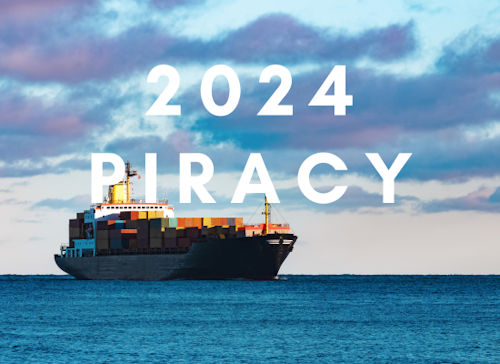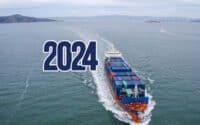9 Potential Piracy Hotspots in 2024

In 2024, maritime piracy continues to pose a significant threat to global shipping routes, with several regions emerging as critical hotspots. From the strategic waters of the Gulf of Guinea to the congested Singapore Straits, pirates are becoming increasingly bold and sophisticated in their attacks. This article identifies and explores nine potential piracy hotspots for 2024, providing detailed insights into the current security challenges and the measures being implemented to safeguard international maritime trade. By understanding these high-risk areas, shipping companies and crews can better prepare and protect themselves against the ever-evolving threat of maritime piracy.
* Please send feedback/suggestions to editor @ shipuniverse.com
1. Gulf of Guinea
Location: West Africa, including the waters off Nigeria, Ghana, and surrounding regions.
Shipping Routes Affected: Major shipping routes connecting Europe, West Africa, and the Americas.
Current Situation: The Gulf of Guinea remains one of the world’s most dangerous regions for maritime piracy. Despite a slight reduction in incidents compared to previous years, the area continues to experience frequent attacks, particularly against tankers and cargo ships. In the first quarter of 2024, six incidents were reported, including the kidnapping of nine crew members from a tanker in January. The pirates in this region are known for their high level of violence and kidnapping for ransom (Marine Insight) (gCaptain).
Measures Taken: International naval patrols and collaboration between regional navies have been increased to combat piracy. The implementation of the Gulf of Guinea Maritime Collaboration Forum (SHADE GoG) and the involvement of private maritime security companies have also contributed to mitigating piracy risks in the region (Marine Insight).
2. Somali Basin and Indian Ocean
Location: Off the coast of Somalia, including the Gulf of Aden, Arabian Sea, and parts of the Indian Ocean.
Shipping Routes Affected: Critical routes between Europe, the Middle East, and Asia, particularly through the Suez Canal.
Current Situation: There has been a resurgence of Somali pirate activity, with several hijackings reported in late 2023 and early 2024. Somali pirates have hijacked dhows and fishing vessels to use as mother ships for launching attacks far from their coastline. Notable incidents include the hijacking of a bulk carrier and five dhows near the Somali coast. Pirates in this region often use automatic weapons and RPGs, posing significant threats to commercial shipping (West of England P&I Club ) (gCaptain).
Measures Taken: Enhanced maritime security measures and adherence to the latest Best Management Practices (BMP 5) are strongly advised for vessels operating in these waters. The Indian Navy and Seychelles Coast Guard have successfully intercepted hijacked vessels and captured pirates, demonstrating effective regional responses to the threat. Continuous vigilance and fortified ship defenses are crucial for navigating these high-risk areas (gCaptain).
3. Malacca Straits
Location: Southeast Asia, between the Malay Peninsula and the Indonesian island of Sumatra.
Shipping Routes Affected: Critical maritime chokepoint for vessels traveling between the Indian Ocean and the Pacific Ocean, including routes to major ports in China, Japan, and South Korea.
Current Situation: The Malacca Straits remains a significant hotspot for piracy due to its strategic importance and heavy maritime traffic. Early 2024 saw several incidents of unauthorized boardings and thefts. Notably, pirates attempted to board a drill ship being towed, underscoring the opportunistic nature of piracy in this region. These incidents highlight ongoing security challenges in one of the world’s busiest shipping lanes (ICC-CCS) (Ship Universe).
Measures Taken: The authorities in the region have intensified patrols and coordinated efforts to improve security. Vessels transiting through the Malacca Straits are advised to enhance vigilance and implement best management practices to deter pirate activities. Crew training and the use of technology, such as surveillance equipment, are critical in mitigating risks (ICC-CCS).
4. Callao Anchorage, Peru
Location: South America, off the coast of Lima, Peru.
Shipping Routes Affected: Shipping routes connecting the Pacific coast of South America to other global regions, including routes to North America and Asia.
Current Situation: The Callao Anchorage has seen a notable increase in piracy incidents, with thirteen reported attacks in recent months. These incidents often involve armed pirates who threaten crew members and steal valuable items from the vessels. Similar patterns of piracy have been observed in other South American ports, such as Macapa, Brazil, Cartagena, and Puerto Bolivar, Colombia (Marine Insight).
Measures Taken: To address the rising piracy threat, authorities are emphasizing immediate reporting of incidents to improve risk assessments and response times. Shipping companies are also encouraged to enhance security measures, such as maintaining vigilant watchkeeping and ensuring robust access control during anchorage (Marine Insight).
5. Singapore Straits
Location: Southeast Asia, between the Straits of Malacca and the South China Sea.
Shipping Routes Affected: Major shipping lane connecting the Indian Ocean to the Pacific Ocean, crucial for vessels heading to and from ports in East Asia.
Current Situation: The Singapore Straits continue to experience significant piracy activity, primarily low-level opportunistic crimes. In 2024, several incidents of robbery involving armed pirates were reported. Pirates often target vessels underway, boarding them to steal valuables and take hostages. A notable incident involved five robbers armed with knives boarding a bulk carrier and taking the duty crew hostage before stealing engine spare parts (ReCAAP ISC) (gCaptain).
Measures Taken: Enhanced maritime security measures have been implemented, including increased patrols and the adoption of Best Management Practices (BMP 5). Ships are advised to maintain strict watchkeeping, secure all access points, and utilize technologies like CCTV for early detection of boarding attempts (ReCAAP ISC).
6. Vung Tau Anchorage, Vietnam
Location: Southeast Asia, off the coast of Vietnam.
Shipping Routes Affected: Key anchorage area for vessels transiting the South China Sea.
Current Situation: Vung Tau Anchorage has seen a rise in piracy incidents in 2024, characterized by unauthorized boardings and thefts. Pirates often target vessels at anchor, taking advantage of lower security measures during stationary periods. A recent incident involved an unauthorized person boarding a cargo ship, though the alert crew managed to raise the alarm, causing the intruder to flee without stealing anything (ICC-CCS) (Marine Insight).
Measures Taken: To counteract these threats, authorities have stressed the importance of immediate incident reporting and maintaining heightened vigilance while at anchor. Crew members are advised to conduct regular security drills, ensure all access points are secured, and maintain a visible security presence to deter potential attackers (ICC-CCS) (Marine Insight).
7. Indonesian Archipelago
Location: Southeast Asia, encompassing the numerous islands of Indonesia.
Shipping Routes Affected: Vital routes connecting the Indian Ocean with the South China Sea and the Pacific Ocean, frequently used by commercial vessels.
Current Situation: The Indonesian Archipelago has seen a rise in piracy incidents in 2024, with several reported attacks targeting anchored ships. Incidents typically involve armed robbers boarding vessels to steal valuables and ship equipment. Recent data indicate a growing number of incidents compared to previous years, highlighting ongoing security challenges in the region. Notable incidents include multiple unauthorized boardings and thefts of engine spares from anchored bulk carriers (ICC-CCS) (ICC – International Chamber of Commerce).
Measures Taken: Maritime authorities have emphasized the importance of immediate reporting and continuous vigilance. Ships are advised to enhance security measures, including regular security drills, ensuring all access points are secure, and maintaining a robust watchkeeping routine. Collaboration between local authorities and international naval forces is crucial to address these threats effectively (ICC-CCS) (ICC-CCS).
8. Chattogram Anchorage, Bangladesh
Location: South Asia, off the coast of Chattogram, Bangladesh.
Shipping Routes Affected: Key anchorage for vessels transiting the Bay of Bengal and the Indian Ocean.
Current Situation: Chattogram Anchorage has experienced several piracy incidents in 2024. Pirates, often armed with knives, target vessels at anchor, taking advantage of the stationary period to board and steal valuables. Despite the crew’s alertness and preparedness, these incidents underscore the persistent security risks in this area. Early 2024 saw multiple attempts at boarding and theft, illustrating the pirates’ continued presence and capability (Ship Universe) (ICC – International Chamber of Commerce).
Measures Taken: To mitigate these risks, ships are encouraged to implement rigorous security protocols, including enhanced watchkeeping and securing all potential entry points. Authorities recommend regular crew training to prepare for potential pirate encounters and ensure the crew can respond effectively during an incident. Reporting any suspicious activity immediately to local authorities is also vital for improving regional maritime security (Ship Universe) (ICC – International Chamber of Commerce).
9. Gulf of Aden
Location: Between Yemen on the Arabian Peninsula, and Somalia in the Horn of Africa, connecting the Red Sea to the Arabian Sea.
Shipping Routes Affected: Major routes between Europe and Asia, including those passing through the Suez Canal.
Current Situation: The Gulf of Aden remains a critical area for maritime piracy. Despite international naval patrols, incidents have continued into 2024, highlighting the persistent threat in this region. Recent data show several attacks, including hijackings and armed robberies, often involving small skiffs launched from mother ships. These attacks tend to be well-coordinated and highly dangerous, targeting a variety of vessels including bulk carriers and fishing vessels (gCaptain) (ICC-CCS).
Measures Taken: International naval forces continue to patrol the Gulf of Aden, working closely with local authorities to deter pirate activities. Vessels transiting this region are advised to follow the latest Best Management Practices (BMP 5), maintain high vigilance, and report any suspicious activity immediately. Ship hardening measures and the use of citadels for crew protection during attacks are also recommended (gCaptain) (ICC-CCS).

Do you have any feedback or additional insights? Please reach out to editor @ shipuniverse.com



